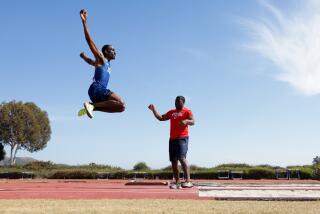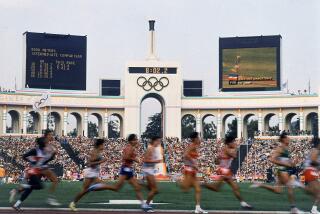Runyan Overcomes Injury to Make Olympic History
- Share via
SACRAMENTO — Marla Runyan qualified for her first Olympic team by finishing third in the women’s 1,500 meters in the U.S. track and field trials at Cal State Sacramento before 23,503 Sunday.
The fact that she became the first legally blind U.S. athlete in any sport to do so was just icing on the cake for the former heptathlete who nearly pulled out of the trials because a tendon injury in her left leg prevented her from running from early June until July 8.
“My vision is just a circumstance that happened,” Runyan said. “I never looked at it as a barrier. I never thought, ‘I want to be the first legally blind Olympian.’ I just wanted to make an Olympic team. Me. Marla.”
Runyan, a 1986 graduate of Camarillo High, has been legally blind since she was 9 years old because of a degenerative condition called Stargardt’s Disease that deteriorates the retinas.
Her peripheral vision is fine, but she sees only “shapes” in her main field of vision.
Despite that, she finished 10th in the heptathlon in the 1996 Olympic trials in Atlanta.
Disappointed with that performance, she focused on the 800--the final event of the heptathlon--in 1997 and ’98 before bursting onto the national scene in the 1,500 last year by winning the Pan American Games and finishing 10th in the World Championships at Seville, Spain.
She won the 3,000 in the USA Track & Field indoor championships in March and ran 15:07.66 in the 5,000 in May to move to ninth on the all-time U.S. performer list. But she strained the tendon that runs from her left knee to her hip June 8 when she jumped out of the way of a child on a bicycle while running on a trail near her home in Eugene, Ore. The injury wasn’t career- or even season-threatening, but it came at a time when Runyan could ill afford to stop running.
She did intensive pool workouts in an effort to maintain her cardiovascular fitness during her time away from the track, but nearly pulled out of the U.S. trials.
“I told my parents on July 4 that I wasn’t going to run,” Runyan said. “But then I kind of caught myself and said, ‘Now wait a minute.’ ”
That turned out to be a wise move.
She posted the second-fastest qualifying time of 4:09.68 in the heats of the 1,500 on Friday before clocking 4:06.44 to finish third behind Regina Jacobs (4:01.01) and Suzy Favor-Hamilton (4:01.81) on Sunday.
“My strategy was basically [to finish] third,” Runyan said. “I said, ‘Regina and Suzy can do whatever they want to do. Just give me third.’ ”
She accomplished that by running toward the back of the 12-woman field for the first 800 meters of the race before moving into eighth place with 600 to go and into sixth entering the final lap of the 400-meter track. She moved into fourth entering the backstretch and surged into third with 250 meters left.
“The pace was such that I felt like I could accelerate if I needed to,” Runyan said. “I kind of had this vision of [Shayne Culpepper] and I battling to the finish for third.”
Culpepper did pass Mary Jayne Harrelson for fourth in the final meters, but she finished nearly two seconds behind Runyan, who said she was “98% sure” that she wouldn’t run in a qualifying heat of the 5,000 today.
Although Runyan says she doesn’t think about her vision “as much as the media does,” she admits that she’s glad to be an inspiration to others.
“I can’t even tell you how many letters I’ve got from parents and children and teenagers who have the same condition I have or something similar,” she said. “And so it makes me feel really good that it has affected people in a positive way.”
More to Read
Go beyond the scoreboard
Get the latest on L.A.'s teams in the daily Sports Report newsletter.
You may occasionally receive promotional content from the Los Angeles Times.






